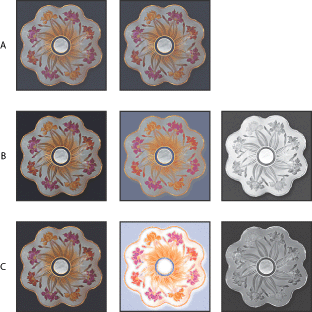Adjusting the separation type and black generation
- In undercolor removal (UCR), black ink is used to replace cyan, magenta, and yellow ink in neutral areas only (that is, areas with equal amounts of cyan, magenta, and yellow). This results in less ink and greater depth in shadows. Because it uses less ink, UCR is used for newsprint and uncoated stock, which generally have greater dot gain than coated stock.
- In gray component replacement (GCR), black ink is used to replace portions of cyan, magenta, and yellow ink in colored areas as well as in neutral areas. GCR separations tend to reproduce dark, saturated colors somewhat better than UCR separations do and maintain gray balance better on press.
To make color separations, the three additive colors (red, green, and blue) are translated into their subtractive counterparts (cyan, magenta, and yellow). In theory, equal parts of cyan, magenta, and yellow combine to subtract all light reflected from the paper and create black. Due to impurities present in all printing inks, however, a mix of these colors instead yields a muddy brown. To compensate for this deficiency in the color separation process, printers remove some cyan, magenta, and yellow in areas where the three colors exist in equal amounts, and they add black ink.
A given color can be translated from RGB mode to CMYK mode in an endless number of ways. But prepress operators typically use one of the following ways to generate black in print:
Choose the type of separation based on your paper stock and the requirements of your print shop.
To adjust the separation type and black generation:
- In the Custom CMYK dialog box, select a separation type.
- If you selected GCR as the separation type, choose an option for Black Generation:
- None generates the color separation using no black plate.
- The Light and Heavy settings decrease and increase the effect of the Medium setting (the default). In most cases, Medium produces the best results.
- Maximum maps the gray value directly to the black plate. This option is useful for images with a large amount of solid black against a light background, such as screen shots from a computer.
- Custom lets you adjust the black generation curve manually. Before choosing Custom, first choose an option (Light, Medium, Heavy, or Maximum) that is closest to the type of black generation you want. This gives you a black generation curve to use as a starting point. Then choose Custom, position the pointer on the curve, and drag to adjust the black curve. The curves for cyan, magenta, and yellow are adjusted automatically relative to the new black curve and the total ink densities.
- If needed, specify values for Black Ink Limit and Total Ink Limit (the maximum ink density your press can support). Check with your print shop to see if you should adjust these values.
- If you selected GCR as the separation type, specify an amount for undercolor addition (UCA) to increase the amount of CMY added to shadow areas. Check with your print shop for the preferred value. If you are unsure of this value, leave it at 0%.
The Separation Options area displays a graph based on current settings showing how neutral colors in the image will separate. In the graph, sometimes called a gray ramp, neutral colors have equal parts of cyan, magenta, and yellow. The horizontal axis represents the neutral color value, from 0% (white) to 100% (black). The vertical axis represents the amount of each ink that will be generated for the given value. In most cases, the cyan curve extends beyond the magenta and yellow curves, because a small extra amount of cyan is required to produce a true neutral.

In the Gray Ramp graph, these limits determine the cutoff points for the CMYK curves.
UCA compensates for the loss of ink density in neutral shadow areas. This additional ink produces rich, dark shadows in areas that might appear flat if printed with only black ink. UCA can also prevent posterization in subtle detail in the shadows.